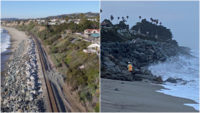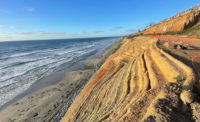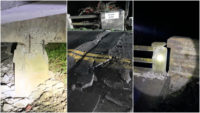The Orange County Transportation Authority (OCTA) launched emergency repairs to a critical Southern California commuter rail connection after safety issues prompted both Amtrak and MetroLink to indefinitely cancel operations on the line over the weekend.
In an emergency meeting on Monday, Oct. 3, the OCTA board unanimously approved emergency measures for repairing the commuter rail running adjacent to the Pacific Ocean on the border of Orange and San Diego counties near the city of San Clemente. The rail lines at that location have been affected by erosion and are showing evidence of shifting.
“This quick action by the Board will allow us to move forward with a more effective interim solution to prevent the tracks from moving and to safely restore rail service through this vital corridor," said OCTA Chairman Mark A. Murphy in a statement.
OCTA officials said the proposed repairs, which are still being finalized, will involve driving large metal anchors into about 700 ft of the slope adjacent to the railroad track to prevent it from pushing the track farther toward the coast. Ground anchors are typically effective in preventing soil movement by installing the steel cables diagonally into the bedrock beneath the slope.
In a schedule presented to the board on Monday, agency officials hope to install temporary ground anchors to stabilize the rail lines and reopen train service sometime in November. Installation of permanent corrosion-resistant ground anchors would begin in Jan. 2023 and be completed in the spring.
The estimated cost for the emergency fix is pegged at $12 million and will likely feature corrodible ground anchors being installed through early November. Design work should be finished by Oct. 7, says James Beil, OCTA executive director capital program, and efforts to procure a specialized contractor with expertise in geotechnical slope stability design and construction has begun.
Darrell Johnson, OCTA CEO, said in the board meeting that they are working with the California Transportation Commission to secure $6 million of the total $12 million.
The section of track is part of a 351-mile Los Angeles – San Diego – San Luis Obispo Rail Corridor (LOSSAN) running through six counties and provides San Diego's only rail link to Los Angeles. It is designated as a national defense rail corridor as part of the Strategic Rail Corridor Network by the Dept. Of Defense. Between Amtrak's Pacific Surfliner and Coaster and Metrolink commuter trains, total ridership is around eight million passengers annually.
OCTA owns the affected section of track, while Metrolink (the Southern California Regional Rail Authority) manages and maintains it. The line carries 10 Metrolink Orange County Line trains each weekday, along with an additional four Inland Empire-Orange County Line trains. The 14 Metrolink trains average just over 1,500 daily weekday boardings.
Commuter service was indefinitely suspended on Thursday, Sept. 29 after geotechnical consultants notified OCTA that previous efforts to stabilize the slope had ceased to work and "OCTA's right-of-way, including the railroad tracks, are in imminent threat of failure," Lee wrote.
The movement necessitated Metrolink suspending its Orange County Line and Inland Empire-Orange County Line service south of the Laguna Niguel/Mission Viejo Station. "Until we have confirmation from experts that the slope movement has stopped, we will not resume Metrolink service," says Scott Johnson, Metrolink spokesperson. "Working with geologists, geotechnical engineers and surveyors, we have determined that to ensure passenger safety, service suspension is necessary."
Amtrak also suspended service on the tracks Sept. 30 "out of an abundance of caution," the agency said in a posted statement. Spokesperson Olivia Irvin says, "Amtrak is working to restore limited service between Irvine and San Diego following a temporary service suspension," but does not have a timeline. Bus service is being offered. Amtrak's statement says that trains will not operate between Irvine and San Diego "until further notice" and that regular service will resume once repairs are completed.
Burlington Northern-Santa Fe is continuing freight service through the area at a reduced speed of no more than 10 miles per hour.
"Engineers have given us clearance to continue to safely operate through this location between Orange and San Diego," says BNSF spokesperson Lena Kent. "Additionally, we have supported the efforts to stabilize the slope by providing riprap and equipment."
The rail line is adjacent to the coastline at the location and, Beil says, the "beach disappeared over the last couple of years." According to OCTA, "significant beach erosion" moved the tracks 28 inches laterally toward the ocean in September 2021. That event caused a train service suspension that lasted less than a month as crews placed 18,000 tons of riprap, largely rocks and boulders, along 700 ft of track to counteract slide.
Monitoring track and slope movement at the site of an ancient landslide has been a constant ever since and further rip rap, along with reducing train speed through the area, wasn't enough to limit additional "incremental movement."
The 2021 suspension of rail service due to the movement of track at milepost 206.8 lasted from Sept. 16 to Oct. 4. Emergency efforts continued in late 2021 and early 2022, which included realigning the track. Inclinometer readings from February 2022 to August 2022 were "relatively stable with nearly no movement," writes OCTA project manager Jason Lee.
The situation changed drastically during September.
"Due to recent higher tidal events, ocean currents and waves and storm surge brought on by Hurricane Kay, a continued slope movement trend began to show in early September 2022," Lee says, "with movement between .01 inches and .04 inches per day."
Metrolink started installing additional riprap on Sept. 13, adding 2,100 tons to date with plans to continue. Beil says that they have been working on a more permanent solution.
Inclinometer readings indicate recent continued slope movement ranging between 1.5 to 2.0 inches at a depth of 20 ft below the tracks. At that current rate, the deflection will require personnel onsite to monitor the situation and potentially stop all rail traffic.
Another segment of the LOSSAN corridor further south has faced similar problems recently. In February of last year, a problematic section of tracks near Del Mar were closed due to severe erosion to the bluffs they run along. Approximately $10 million in repairs were completed this summer.
A proposal to route the commuter line inland via a tunnel has gained momentum in recent years. Last month, the San Diego Association of Governments accepted a $300-million state grant from the California State Transportation Agency's Transit and Intercity Rail Capital Program to develop the proposal.






Post a comment to this article
Report Abusive Comment